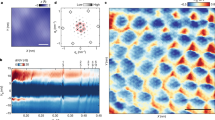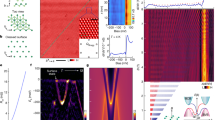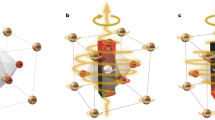Abstract
The control of charge transport in an active electronic device depends intimately on the modulation of the internal charge density by an external node1. For example, a field-effect transistor relies on the gated electrostatic modulation of the channel charge produced by changing the relative position of the conduction and valence bands with respect to the electrodes. In molecular-scale devices2,3,4,5,6,7,8,9,10, a longstanding challenge has been to create a true three-terminal device that operates in this manner (that is, by modifying orbital energy). Here we report the observation of such a solid-state molecular device, in which transport current is directly modulated by an external gate voltage. Resonance-enhanced coupling to the nearest molecular orbital is revealed by electron tunnelling spectroscopy, demonstrating direct molecular orbital gating in an electronic device. Our findings demonstrate that true molecular transistors can be created, and so enhance the prospects for molecularly engineered electronic devices.
This is a preview of subscription content, access via your institution
Access options
Subscribe to this journal
Receive 51 print issues and online access
$199.00 per year
only $3.90 per issue
Buy this article
- Purchase on Springer Link
- Instant access to full article PDF
Prices may be subject to local taxes which are calculated during checkout




Similar content being viewed by others
References
Ahn, C. H. et al. Electrostatic modification of novel materials. Rev. Mod. Phys. 78, 1185–1212 (2006)
Joachim, C., Gimzewski, J. K. & Aviram, A. Electronics using hybrid-molecular and mono-molecular devices. Nature 408, 541–548 (2000)
Galperin, M., Ratner, M. A., Nitzan, A. & Troisi, A. Nuclear coupling and polarization in molecular transport junctions: beyond tunneling to function. Science 319, 1056–1060 (2008)
Reed, M. A., Zhou, C., Muller, C. J., Burgin, T. P. & Tour, J. M. Conductance of a molecular junction. Science 278, 252–254 (1997)
Aviram, A. & Ratner, M. A. Molecular rectifiers. Chem. Phys. Lett. 29, 277–283 (1974)
Ghosh, A. W., Rakshit, T. & Datta, S. Gating of a molecular transistor: electrostatic and conformational. Nano Lett. 4, 565–568 (2004)
Andrews, D. Q., Solomon, G. C., Van Duyne, R. P. & Ratner, M. A. Single molecule electronics: increasing dynamic range and switching speed using cross-conjugated species. J. Am. Chem. Soc. 130, 17309–17319 (2008)
Park, J. et al. Coulomb blockade and the Kondo effect in single-atom transistors. Nature 417, 722–725 (2002)
Liang, W., Shores, M. P., Bockrath, M., Long, J. R. & Park, H. Kondo resonance in a single-molecule transistor. Nature 417, 725–729 (2002)
Kubatkin, S. et al. Single-electron transistor of a single organic molecule with access to several redox states. Nature 425, 698–701 (2003)
Xu, B., Xiao, X., Yang, X., Zang, L. & Tao, N. Large gate modulation in the current of a room temperature single molecule transistor. J. Am. Chem. Soc. 127, 2386–2387 (2005)
Piva, P. G. et al. Field regulation of single-molecule conductivity by a charged surface atom. Nature 435, 658–661 (2005)
Datta, S. S., Strachan, D. R. & Johnson, A. T. C. Gate coupling to nanoscale electronics. Phys. Rev. B 79, 205404 (2009)
Ghosh, S. et al. Device structure for electronic transport through individual molecules using nanoelectrodes. Appl. Phys. Lett. 87, 233509 (2005)
Xu, B. & Tao, N. J. Measurement of single-molecule resistance by repeated formation of molecular junctions. Science 301, 1221–1223 (2003)
Venkataraman, L., Klare, J. E., Nuckolls, C., Hybertsen, M. S. & Steigerwald, M. L. Dependence of single-molecule junction conductance on molecular conformation. Nature 442, 904–907 (2006)
Wang, W., Lee, T. & Reed, M. A. Mechanism of electron conduction in self-assembled alkanethiol monolayer devices. Phys. Rev. B 68, 035416 (2003)
Beebe, J. M., Kim, B., Gadzuk, J. W., Frisbie, C. D. & Kushmerick, J. G. Transition from direct tunneling to field emission in metal-molecule-metal junctions. Phys. Rev. Lett. 97, 026801 (2006)
Jaklevic, R. C. & Lambe, J. Molecular vibration spectra by electron tunneling. Phys. Rev. Lett. 17, 1139–1140 (1966)
Stipe, B. C., Rezaei, M. A. & Ho, W. Single-molecule vibrational spectroscopy and microscopy. Science 280, 1732–1735 (1998)
Wang, W., Lee, T., Kretzschmar, I. & Reed, M. A. Inelastic electron tunneling spectroscopy of an alkanedithiol self-assembled monolayer. Nano Lett. 4, 643–646 (2004)
Kushmerick, J. G. et al. Vibronic contributions to charge transport across molecular junctions. Nano Lett. 4, 639–642 (2004)
Galperin, M., Ratner, M. A. & Nitzan, A. On the line widths of vibrational features in inelastic electron tunneling spectroscopy. Nano Lett. 4, 1605–1611 (2004)
Shimazaki, T. & Asai, Y. Theoretical study of the lineshape of inelastic electron tunneling spectroscopy. Phys. Rev. B 77, 115428 (2008)
Troisi, A., Ratner, M. A. & Nitzan, A. Vibronic effects in off-resonant molecular wire conduction. J. Chem. Phys. 118, 6072–6082 (2003)
Galperin, M., Ratner, M. A. & Nitzan, A. Inelastic electron tunneling spectroscopy in molecular junctions: peaks and dips. J. Chem. Phys. 121, 11965–11979 (2004)
Persson, B. N. J. & Baratoff, A. Inelastic electron tunneling from a metal tip: the contribution from resonant processes. Phys. Rev. Lett. 59, 339–342 (1987)
Komeda, T. Chemical identification and manipulation of molecules by vibrational excitation via inelastic tunneling process with scanning tunneling microscopy. Prog. Surf. Sci. 78, 41–85 (2005)
Yu, L. H., Zangmeister, C. D. & Kushmerick, J. G. Origin of discrepancies in inelastic electron tunneling spectra of molecular junctions. Phys. Rev. Lett. 98, 206803 (2007)
Troisi, A. & Ratner, M. A. Propensity rules for inelastic electron tunneling spectroscopy of single-molecule transport junctions. J. Chem. Phys. 125, 214709 (2006)
Acknowledgements
This work was supported by the Korean National Research Laboratory programme; a Korean National Core Research Center grant; the World Class University programme of the Korean Ministry of Education, Science and Technology; the Program for Integrated Molecular System at the Gwangju Institute of Science and Technology; the SystemIC2010 project of the Korean Ministry of Knowledge Economy; the US Army Research Office (W911NF-08-1-0365); and the Canadian Institute for Advanced Research.
Author Contributions T.L. planned and supervised the project; H.S. designed and performed the experiments; H.S., T.L. and M.A.R. analysed and interpreted the data and wrote the manuscript; H.J. designed the electrical measurement systems; Y.K. assisted in low-temperature electrical measurements; and Y.H.J. performed DFT calculations.
Author information
Authors and Affiliations
Corresponding authors
Ethics declarations
Competing interests
The authors declare no competing financial interests.
Supplementary information
Supplementary Information
This file contains Supplementary Methods, Supplementary Figures S1-S10 with Legends, Supplementary Notes and Data, Supplementary Table S1 and Supplementary References. (PDF 800 kb)
Rights and permissions
About this article
Cite this article
Song, H., Kim, Y., Jang, Y. et al. Observation of molecular orbital gating. Nature 462, 1039–1043 (2009). https://doi.org/10.1038/nature08639
Received:
Accepted:
Issue Date:
DOI: https://doi.org/10.1038/nature08639
This article is cited by
-
Single-molecule photoelectron tunnelling spectroscopy
Nature Materials (2023)
-
Mapping frontier molecular orbitals using photocurrents
Science China Materials (2023)
-
On-chip integrated process-programmable sub-10 nm thick molecular devices switching between photomultiplication and memristive behaviour
Nature Communications (2022)
-
Precise electrical gating of the single-molecule Mizoroki-Heck reaction
Nature Communications (2022)
-
Plasmonic phenomena in molecular junctions: principles and applications
Nature Reviews Chemistry (2022)
Comments
By submitting a comment you agree to abide by our Terms and Community Guidelines. If you find something abusive or that does not comply with our terms or guidelines please flag it as inappropriate.



